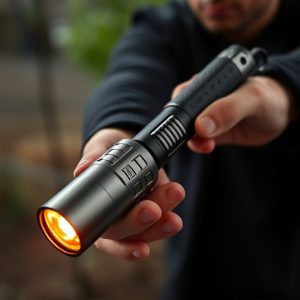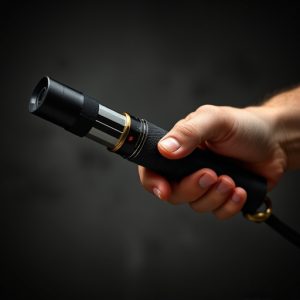Maximizing Safety with Self-Defense Expandable Batons: A Legal and Practical Guide
A self-defense expandable baton is a versatile and effective tool for personal safety, combining po…….
A self-defense expandable baton is a versatile and effective tool for personal safety, combining portability with an extended reach. It's made from high-strength materials like aluminum for durability without added weight, and features robust locking mechanisms to ensure it remains either extended or retracted during use. An ergonomic grip enhances control under pressure. For effective use, one must be aware of the legal implications and ensure the baton complies with local laws, as regulations vary by jurisdiction. Regular training is crucial for mastering deployment, retracting, and proper striking techniques, targeting vulnerable areas to deter assailants. Users should engage in comprehensive training that includes scenario drills and evasion tactics, all within a legal framework to guarantee responsible self-defense practices. This approach ensures that the expandable baton is used effectively and safely as part of a well-rounded personal protection strategy.
When considering personal safety, a self-defense expandable baton emerges as a prudent choice for many. This article serves as a definitive guide, illuminating the essential aspects of using an expandable baton for self-defense. We’ll explore its key features, delve into legal guidelines for possession and use, and offer practical training techniques to ensure effective deployment in critical situations. Understanding the nuances of this self-defense tool is paramount for those looking to enhance their personal protection arsenal.
Understanding the Self-Defense Expandable Baton: A Comprehensive Guide
When considering a self-defense tool, the self-defense expandable baton stands out as a versatile and effective option. Unlike traditional fixed-blade batons, the expandable design offers several advantages. It is compact for easy carrying and concealment, yet rapidly extends to a formidable length upon deployment, allowing users to respond quickly to threats. This feature ensures that the baton remains discreet when not in use but becomes an effective deterrent when necessary.
Selecting the right self-defense expandable baton involves understanding its components and functionality. It is constructed with high-strength aluminum or other durable materials, providing both lightweight and sturdy options. The locking mechanism within these batons is crucial for user safety; it must securely hold the baton in either its closed or extended state to prevent accidental collapses during use. Additionally, the grip should be ergonomically designed to ensure firm control, even in high-stress situations. Users should also consider the legal implications and local laws regarding the possession and use of expandable batons before incorporating one into their self-defense strategy. Regular maintenance is also vital to keep the mechanism functioning smoothly and to ensure the baton remains a reliable component of your personal protection arsenal.
Key Features of Personal Protection Batons: What to Look For
When considering a personal protection baton for self-defense, it’s crucial to evaluate several key features that can influence its effectiveness and your safety. An expandable baton, unlike its fixed length counterparts, offers versatility and compactness when not in use, but extends to a longer form when needed, providing a greater reach and striking power. Look for models that lock into place at the desired length to ensure accuracy and control during confrontations. The material from which the baton is made is also an important factor; high-strength aluminum or aircraft-grade steel can offer both durability and lightweight portability, making it easy to carry without weighing you down.
Safety mechanisms are another critical aspect to consider in an expandable baton for self-defense. A model with a safe-grip design helps prevent the baton from slipping out of your hands during use, which is essential under stress. Additionally, some batons come with training videos or instructional materials, so you can familiarize yourself with proper techniques and legal uses. The ease of deployment—how quickly and effectively the baton can be extended—can also be a determining factor, as this feature may be critical in a sudden threat situation. Always ensure that the baton you choose complies with local laws and regulations regarding self-defense tools.
Legal Considerations When Carrying an Expandable Baton for Self-Defense
When considering personal protection, an expandable baton can be a practical choice for self-defense due to its compact size and ease of use. However, it’s imperative to navigate the legal landscape governing the possession and use of such self-defense tools. Laws vary by jurisdiction, and individuals must be aware that certain regulations apply to the carrying and deployment of expandable batons. In many places, there are specific laws dictating where and how these devices can be legally carried, as well as under what circumstances they may be used in self-defense. It’s crucial to familiarize oneself with local statutes, as unauthorized possession or misuse can lead to legal consequences. Understanding the legal parameters is not just a matter of compliance but also ensures that one’s use of an expandable baton aligns with the intent of self-defense laws. Prospective owners should research their state and local laws, obtain any necessary permits, and receive proper training on the correct handling of the baton to avoid any legal pitfalls. This due diligence not only upholds one’s rights but also reinforces the responsible use of self-defense expandable batons in various situations.
Effective Techniques and Training for Using Your Expandable Baton in Self-Defense Situations
When it comes to effective techniques and training for using an expandable baton in self-defense situations, understanding the mechanics and proper handling of the device is paramount. The self defense expandable baton is a compact yet potent tool that can be deployed with rapid speed and precision when faced with an aggressor. Training should focus on mastering the one-handed deployment and retraction techniques, which are crucial for maintaining control over the situation and ensuring the baton is always ready for use. Practicing in controlled environments allows individuals to learn proper striking techniques, aiming for vulnerable areas such as the eyes, nose, throat, and joints. These training sessions should also emphasize situational awareness, de-escalation strategies, and legal considerations, as effective self-defense is not solely about physical tools but also about mental preparedness.
Advanced training programs often incorporate drills that simulate real-world scenarios, teaching users how to effectively use their expandable baton in conjunction with other self-defense skills. These may include evasion maneuvers, defensive stance, and the use of verbal commands to deter attackers. Additionally, it’s important to familiarize oneself with the local laws regarding the use of an expandable baton for self-defense, ensuring that one’s actions are justified and within legal boundaries in the event of a confrontation. Regular practice with the baton, under the guidance of a qualified instructor, will instill confidence and ensure that when the need arises, the user can rely on their training to respond effectively and protect themselves safely.


